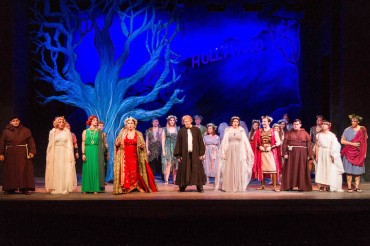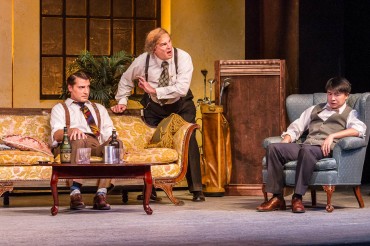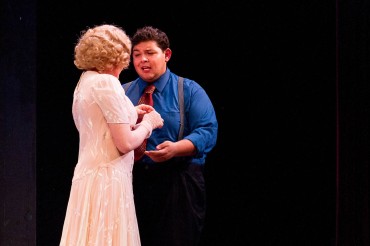The Well-Tempered Ear
Classical music: University Opera’s updated Hollywood production of Verdi’s “Falstaff” proves a triumph on all counts. Plus, FREE Opera Scenes concert is Tuesday night | November 20, 2016
By Jacob Stockinger
Here is a guest review by The Opera Guy of Giuseppe’s Verdi’s “Falstaff” as staged by the University Opera. Performance photos are by Michael Anderson.
By Larry Wells
In the past few years I’ve seen Verdi’s “La Forza del Destino” set in the Spanish Civil War, Wagner’s Ring cycle re-imagined as the history of cinema, and Puccini’s “Turandot” presented as a performance by a traveling circus.
Thus, Verdi’s ‘Falstaff’ set in 1930’s Hollywood seemed a reasonable reinterpretation, and so it proved at its final performance Tuesday evening by University Opera.
“Falstaff,” drawn from three plays by Shakespeare, is Verdi’s final opera and a rare comedy. More importantly, gone are his familiar forms of a recitative followed by an aria with lots of oom-pa-pa orchestral accompaniment, now replaced with a conversational style that to me shows Wagner’s influence. It just doesn’t sound like Verdi, but it certainly sounds good.
I felt that the whole evening was a triumph.
The sets were beautifully dressed, the costumes were excellent and the lighting was effective.
The UW Symphony Orchestra, conducted by James Smith, played wonderfully, although from where I sat the sound was occasionally muffled.
Thank goodness a new music building is being built, and I trust that there will be a theater within it that will accommodate operatic performances. The current Music Hall has its limitations, one being that much of the orchestra was playing underneath the stage and another being that for some reason the theater’s temperature cannot be controlled. It was stiflingly hot during the performance.
As for the singing and acting, the cast I saw was uniformly strong. Falstaff, performed by UW-Madison faculty member Paul Rowe (below), was very robust and was particularly affecting during his act III soliloquy. The Ear mentioned to me his Oliver Hardy mannerisms, and once I noticed that I was constantly amused.
Yanzelmalee Rivera as Alice was hilarious in her seduction scene and really came alive in Act III. Courtney Kayser as Meg was a compelling comic actress. Rebecca Buechel’s Mistress Quickly was an equally adept comic actress and had an excellent voice. Emily Weaver as Nannetta was a beautiful singer who shone in her third act moments as Queen of the Fairies. These four women had some outstanding ensemble moments, and I was constantly diverted by their antics as they outwitted the men.
Among the hapless male characters, Brian Schneider was a standout as Ford and the deep voice of Benjamin Schultz (below left, with Paul Rowe and Jiabao Zhang) made the minor character Pistola noticeable whenever he was on stage.
But the voice of the evening belonged to tenor José Daniel Muñiz (below right) as Fenton. He excelled not only in his solo moments but blended extremely well with his paramour Nannetta (Claire Powling, below left).
The outstanding ensemble work exhibited throughout the opera culminated in the grand fugue at the end of the opera, and the nearly full-house audience was blown away by those final moments. (You can hear the fugal finale, conducted by Sir George Solti, in a YouTube video at the bottom.)
The 1930’s Hollywood concept worked well. It seemed completely fitting and was undoubtedly more amusing than it would have been had the opera been set in the time of Henry IV.
“Well done” to the University Opera’s new full-time director David Ronis (below center) for his imagination and direction. I look forward to his production of Benjamin Britten’s “Turn of the Screw” in early March.
And since this University Opera production and other events are being presented to commemorate the 400th anniversary of Shakespeare’s death and the exhibition of a First Folio at the Chazen Museum of Art, I want to put in a plug for Ralph Vaughan Williams’ “Sir John in Love” which has almost exactly the same plot as “Falstaff” and is woefully underperformed.
I also want to draw your attention the FREE Opera Scenes concert by University Opera that will be presented this Tuesday night, Nov. 22, at 7:30 p.m. in Music Hall. Featured are singers, with piano accompaniment, in scenes from: Charles Gounod’s “Faust”; Claudio Monteverdi’s “The Coronation of Poppea“; Giacomo Puccini‘s “La Rondine”; Leonard Bernstein‘s “Trouble in Tahiti”; Gioacchino Rossini’s “The Barber of Seville”; Dominick Argento’s “Postcard From Morocco”; and Marc Blitzstein’s”Regina.”
Tags: accompaniment, Arts, Barber of Seville, Beethoven, Benjamin Britten, Charles Gounod, Chazen Museum of Art, choral music, Christina and Michelle Naughton, cinema, circus, Civil War, Classical music, concerto, Dominick Argento, Edo de Waart, Falstaff, Faust, Francis Poulenc, fugue, Giacomo Puccini, Gounod, Hollywood, Igor Stravinsky, Jacob Stockinger, La Forza del Destino, La Rondine, Laurel and Hardy, Leonard Bernstein, Ludwig van Beethoven, Madison, Marc Blitzstein, Milwaukee Symphony Orchestra, Monteverdi, Music, Oliver Hardy, opera, Orchestra, Piano, Postcard From Morocco, Puccini, Ring cycle, Rossini, scenes, Shakespeare, Sir John in Love, Solti, Spain, Spanish Civil War, symphony, The Coronation of Poppea, Trouble in Tahiti, Turandot, Turn of the Screw, United States, University of Wisconsin-Madison School of Music, University of Wisconsin–Madison, University Opera, vaughan williams, Verdi, Wagner, wisconsin public radio, YouTube
Leave a Comment »
This site uses Akismet to reduce spam. Learn how your comment data is processed.
- May 2024
- April 2024
- March 2024
- February 2024
- January 2024
- December 2023
- November 2023
- October 2023
- September 2023
- August 2023
- July 2023
- June 2023
- May 2023
- April 2023
- March 2023
- February 2023
- January 2023
- December 2022
- October 2022
- September 2022
- June 2022
- May 2022
- April 2022
- March 2022
- July 2021
- June 2021
- May 2021
- April 2021
- March 2021
- February 2021
- January 2021
- December 2020
- November 2020
- October 2020
- September 2020
- August 2020
- July 2020
- June 2020
- May 2020
- April 2020
- March 2020
- February 2020
- January 2020
- December 2019
- November 2019
- October 2019
- September 2019
- August 2019
- July 2019
- June 2019
- May 2019
- April 2019
- March 2019
- February 2019
- January 2019
- December 2018
- November 2018
- October 2018
- September 2018
- August 2018
- July 2018
- June 2018
- May 2018
- April 2018
- March 2018
- February 2018
- January 2018
- December 2017
- November 2017
- October 2017
- September 2017
- August 2017
- July 2017
- June 2017
- May 2017
- April 2017
- March 2017
- February 2017
- January 2017
- December 2016
- November 2016
- October 2016
- September 2016
- August 2016
- July 2016
- June 2016
- May 2016
- April 2016
- March 2016
- February 2016
- January 2016
- December 2015
- November 2015
- October 2015
- September 2015
- August 2015
- July 2015
- June 2015
- May 2015
- April 2015
- March 2015
- February 2015
- January 2015
- December 2014
- November 2014
- October 2014
- September 2014
- August 2014
- July 2014
- June 2014
- May 2014
- April 2014
- March 2014
- February 2014
- January 2014
- December 2013
- November 2013
- October 2013
- September 2013
- August 2013
- July 2013
- June 2013
- May 2013
- April 2013
- March 2013
- February 2013
- January 2013
- December 2012
- November 2012
- October 2012
- September 2012
- August 2012
- July 2012
- June 2012
- May 2012
- April 2012
- March 2012
- February 2012
- January 2012
- December 2011
- November 2011
- October 2011
- September 2011
- August 2011
- July 2011
- June 2011
- May 2011
- April 2011
- March 2011
- February 2011
- January 2011
- December 2010
- November 2010
- October 2010
- September 2010
- August 2010
- July 2010
- June 2010
- May 2010
- April 2010
- March 2010
- February 2010
- January 2010
- December 2009
- November 2009
- October 2009
- September 2009
- August 2009
Archives
- 2,490,468 hits
Blog Stats
- Beethoven’s Ninth turns 200 today May 7, 2024
- Pianist Yuja Wang’s new ‘Vienna Recital’ is another triumph May 4, 2024
- Gramophone names the 50 best classical recordings of 2024 — so far May 2, 2024
- What classical music is good for studying, reading and writing? April 30, 2024
- Meet and hear piano phenom Yunchan Lim April 24, 2024
Recent Posts
Recent Comments
| welltemperedear on Beethoven’s Ninth turns 200… | |
| Robert Graebner on Beethoven’s Ninth turns 200… | |
| bevaconme on Pianist Yuja Wang’s new ‘Vienn… | |
| bevaconme on How did pianist Yuja Wang’s he… | |
| welltemperedear on Classical music plus tips for… |
Tags
#BlogPost #BlogPosting #ChamberMusic #FacebookPost #FacebookPosting #MeadWitterSchoolofMusic #TheEar #UniversityofWisconsin-Madison #YouTubevideo Arts audience Bach Baroque Beethoven blog Cello Chamber music choral music Classical music Compact Disc composer Concert concerto conductor Early music Facebook forward Franz Schubert George Frideric Handel Jacob Stockinger Johannes Brahms Johann Sebastian Bach John DeMain like link Ludwig van Beethoven Madison Madison Opera Madison Symphony Orchestra Mead Witter School of Music Mozart Music New Music New York City NPR opera Orchestra Overture Center performer Pianist Piano post posting program share singer Sonata song soprano String quartet Student symphony tag The Ear United States University of Wisconsin-Madison School of Music University of Wisconsin–Madison Viola Violin vocal music Wisconsin Wisconsin Chamber Orchestra wisconsin public radio Wolfgang Amadeus Mozart YouTube




Leave a comment